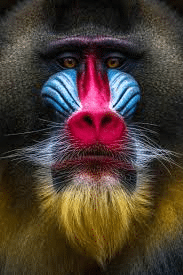The Psychology of Colour (aka, why South House should win Sports’ Day….)
Dear all,
Our Thought for the Week continues our series on the colours we use to represent our ten Houses – this time it’s the Red of South House in the spotlight, and specifically the idea that different colours affect us in different ways – otherwise known as the ‘psychology of colour’.
Red is perhaps the most potent colour of all, partly because it was used extensively by our ancestors, who painted their bodies with red ochre as a symbol of life and vitality. In fact, the ability to distinguish between red and green was an evolutionary trait that marked our early primate ancestors out from other mammals (many of which still cannot distinguish between these two colours). This gave a competitive advantage in helping spot ripe red fruits among green foliage.
Red is also a sign of dominance in many primates – the best example is mandrill monkeys, whose vivid red markings signal their position in the group hierarchy: the more dominant they are, the redder they appear.
But does the colour red have any modern-day effects on us? A study conducted at the 2004 Olympics in Athens compared boxers who wore the two competing colours – red and blue – and found that those wearing red kits were slightly more likely to win, despite being randomly assigned their colours. The researchers concluded that wearing red didn’t make the competitors better boxers, but it seemingly helped tip the balance in their favour when matched with an opponent wearing blue.
This has also been seen in football, where penalty-takers are less likely to score against goalkeepers wearing red.
Researchers have hypothesised that the reasons for this may include a sense that people who wear red feel more dominant, triggering an increased heart rate and testosterone boost that could improve their performance. Alternatively, wearing red might intimidate opponents, in the same way that less dominant mandrill monkeys may avoid approaching their leaders, whose faces (and bottoms!) are much redder than theirs.
However, it’s not all positive. Wearing something that is bright red can sometimes trigger feelings of aggression, while one study suggested that in an exam situation, people tended to perform worse in tests when they were printed on a red background. It’s even been shown that in casinos people tend to bet more if they have red chips than is the case with other colours.
Colour psychology is still a relatively new field of study so none of the findings mentioned above are beyond doubt, but in an age of ‘marginal gains’ where the top athletes, business and political leaders – as well as those driving change in the field of Artificial Intelligence – are all seeking competitive advantage, it will be interesting to see how colours might be used to influence our performance and how others perceive us.
For now, all that remains is to wish our nine other Houses luck as they seek to overcome South’s potential advantage at Sports’ Day…
Enjoy the Bank Holiday weekend
Best wishes
Michael Bond




